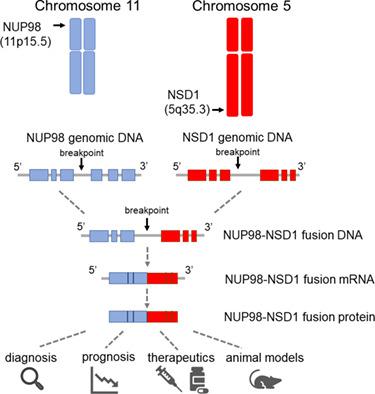当前位置:
X-MOL 学术
›
STEM CELLS
›
论文详情
Our official English website, www.x-mol.net, welcomes your
feedback! (Note: you will need to create a separate account there.)
Clinical and Molecular Consequences of Fusion Genes in Myeloid Malignancies
STEM CELLS ( IF 4.0 ) Pub Date : 2020-08-03 , DOI: 10.1002/stem.3263 Toshihiro Matsukawa 1 , Peter D Aplan 1
STEM CELLS ( IF 4.0 ) Pub Date : 2020-08-03 , DOI: 10.1002/stem.3263 Toshihiro Matsukawa 1 , Peter D Aplan 1
Affiliation

|
Leukemias are heterogeneous diseases characterized by aberrant hematopoietic stem and progenitor cells (HSPCs). Oncogenic fusion genes and proteins, produced via gross chromosomal rearrangements, such as chromosomal translocation, insertion, and inversion, play important roles in hematologic malignancies. These oncoproteins alter fundamental cellular properties, such as self‐renewal, differentiation, and proliferation, and confer leukemogenic potential to HSPCs. In addition to providing fundamental insights into the process of leukemic transformation, these fusion genes provide targets for treatment and monitoring of myeloid leukemias. Furthermore, new technologies such as next‐generation sequencing have allowed additional insights into the nature of leukemic fusion genes. In this review, we discuss the history, biologic effect, and clinical impact of fusion genes in the field of myeloid leukemias.
中文翻译:

融合基因在髓系恶性肿瘤中的临床和分子后果
白血病是异质性疾病,其特征在于异常的造血干细胞和祖细胞 (HSPC)。通过染色体易位、插入和倒位等总体染色体重排产生的致癌融合基因和蛋白质在血液系统恶性肿瘤中发挥重要作用。这些癌蛋白改变了基本的细胞特性,例如自我更新、分化和增殖,并赋予 HSPC 致白血病潜能。除了提供对白血病转化过程的基本见解之外,这些融合基因还为治疗和监测髓系白血病提供了靶点。此外,新一代测序等新技术使人们对白血病融合基因的性质有了更多的了解。在这篇综述中,我们讨论了历史、生物学效应、
更新日期:2020-08-03
中文翻译:

融合基因在髓系恶性肿瘤中的临床和分子后果
白血病是异质性疾病,其特征在于异常的造血干细胞和祖细胞 (HSPC)。通过染色体易位、插入和倒位等总体染色体重排产生的致癌融合基因和蛋白质在血液系统恶性肿瘤中发挥重要作用。这些癌蛋白改变了基本的细胞特性,例如自我更新、分化和增殖,并赋予 HSPC 致白血病潜能。除了提供对白血病转化过程的基本见解之外,这些融合基因还为治疗和监测髓系白血病提供了靶点。此外,新一代测序等新技术使人们对白血病融合基因的性质有了更多的了解。在这篇综述中,我们讨论了历史、生物学效应、











































 京公网安备 11010802027423号
京公网安备 11010802027423号